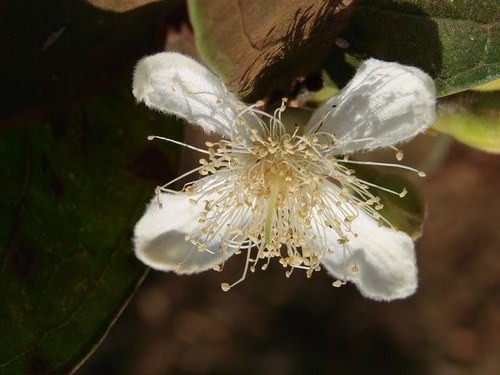Savannah cherry
(Eugenia liberiana)

Description
Eugenia calycina, also known as savannah cherry, field cherry, Jabuti cherry, Grao de galo, cerejinha, cereja de cerrado, pitanga-vermelha, red pitanga, pitanga cherry of cerrado, and ca-ajaboti, is a flowering shrub in the family Myrtaceae. Eugenia calycina is native to Brazil, including but not exclusive to the states of Goias, Sao Paulo, Minas Gerais, Mato Grosso do Sul, and Parana. It grows wild in savannahs and fields up to 1600 meters (5249 feet) in elevation, especially in drier areas. Eugenia calycina grows up to 2 meters (6.5 feet) in height, although is normally between 0.7 meters (2 feet) and 1.5 meters (5 feet). The narrow, coriaceous leaves are evergreen and elliptic in shape. The flowers are pinkish-white with four round petals. They arise to new settlements on the side or edge among the stalks and measure 1.5-5.8 centimeters (0.5-2 inches) in length. The oblong fruit is dark red to purple when ripe and measures 2.5 centimeters (1 inch) in length and 1.5 centimeters (0.5 inches) in width. There are at least two pointed, cordate-based, ovate bracts measuring 0.9-2.2 centimeters (0.3-0.8 inches) in length at the base of each fruit. It is edible and has a mild, sweet, berry-like flavor. It contains a single recalcitrant seed which germinates after 30-45 days of being planted. Seedling growth is rapid, with the plant often reaching 20 centimeters (8 inches) at 10 months of age. It fruits from November to January and flowers in spring. Fruiting begins when the plant is 2-3 years of age. The plant prefers positions in full sun or partial shade and tolerates semi-arid, rainy temperate, and subtropical to tropical dry and wet climates. They tolerate frost down to -4 C (25 F) and tolerate heat to 42 C (107 F). It tolerates sandy-loam soils and sand soils with quartz. The pH can range from 4.5 to 6.7, with some moisture
Taxonomic tree:







